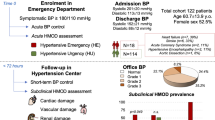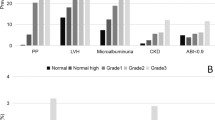Abstract
The prevalence of malignant hypertension has clearly fallen with the advent of anti-hypertensive medication but has remained stable over the past 30–40 years in spite of progress in diagnosis and management of hypertension. A diagnosis of malignant hypertension is usually based on the association of severely elevated blood pressure with a Keith and Wagener stage III or IV retinopathy. We believe that this definition can be reconsidered for several reasons. Although simple and pragmatic, this definition corresponds to a time when there were few techniques for assessment of hypertensive target organ involvement, and does not take into account involvement of kidney, brain and heart; whereas the overall prognosis largely depends on how much they are affected. On the contrary, the acute blood pressure level and especially diastolic should not be a hard diagnostic criterion as it does not itself constitute the prognosis of the condition. We propose to consider that malignant hypertension with retinopathy is only one of a number of possible presentation(s) of acute hypertension with multi organ damage (hypertension multi organ damage (MOD)) and that the recognition of these hypertensive emergencies, when retinopathy is lacking, be based on acute elevation of BP associated with impairment of at least three different target organs. The objective of a new and expanded definition is to facilitate recognition of these true emergencies. The condition is more common than usually perceived and would have a much worse prognosis than the usual forms of hypertension. Early recognition and management of hypertension-MOD are fundamental to any improvement in prognosis.
This is a preview of subscription content, access via your institution
Access options
Subscribe to this journal
Receive 12 digital issues and online access to articles
$119.00 per year
only $9.92 per issue
Buy this article
- Purchase on Springer Link
- Instant access to full article PDF
Prices may be subject to local taxes which are calculated during checkout
Similar content being viewed by others
References
Lip GY, Beevers M, Beevers DG . Do patients with de novo hypertension differ from patients with previously known hypertension when malignant phase hypertension occurs? Am J Hypertens 2000; 13: 934–939.
Ahmed ME, Walker JM, Beevers DG, Beevers M . Lack of difference between malignant and accelerated hypertension. Br Med J (Clin Res Ed) 1986; 292: 235–237.
Gonzalez R, Morales E, Segura J, Ruilope LM, Praga M . Long-term renal survival in malignant hypertension. Nephrol Dial Transplant 2010; 25: 3266–3272.
Lip GY, Beevers M, Beevers DG . Does renal function improve after diagnosis of malignant phase hypertension? J Hypertens 1997; 15: 1309–1315.
Amraoui F, Van Der Hoeven NV, Van Valkengoed IG, Vogt L, Van Den Born BJ . Mortality and cardiovascular risk in patients with a history of malignant hypertension: a case-control study. J Clin Hypertens (Greenwich) 2014; 16: 122–126.
Pak KJ, Hu T, Fee C, Wang R, Smith M, Bazzano LA . Acute hypertension: a systematic review and appraisal of guidelines. Ochsner J 2014; 14: 655–663.
Shantsila A, Shantsila E, Lip GY . Malignant hypertension: a rare problem or is it underdiagnosed? Curr Vasc Pharmacol 2010; 8: 775–779.
van den Born BJ, Koopmans RP, Groeneveld JO, van Montfrans GA . Ethnic disparities in the incidence, presentation and complications of malignant hypertension. J Hypertens 2006; 24: 2299–2304.
Lip GY, Beevers M, Beevers G . The failure of malignant hypertension to decline: a survey of 24 years' experience in a multiracial population in England. J Hypertens 1994; 12: 1297–1305.
Lane DA, Lip GY, Beevers DG . Improving survival of malignant hypertension patients over 40 years. Am J Hypertens 2009; 22: 1199–1204.
Leishman AW . Hypertension: treated and untreated; a study of 400 cases. Br Med J 1959; 1: 1361–1368.
Lip GY, Beevers M, Beevers DG . Complications and survival of 315 patients with malignant-phase hypertension. J Hypertens 1995; 13: 915–924.
Shantsila A, Lane DA, Beevers DG, Lip GY . Lack of impact of pulse pressure on outcomes in patients with malignant phase hypertension: the West Birmingham Malignant Hypertension study. J Hypertens 2012; 30: 974–979.
Pimenta E, Calhoun DA . Hypertensive crisis: forget the numbers. J Hypertens 2012; 30: 882–883.
Gosse P, Coulon P, Papaioannou G, Litalien J, Lemetayer P . Impact of malignant arterial hypertension on the heart. J Hypertens 2011; 29: 798–802.
Mancia G, Fagard R, Narkiewicz K, Redon J, Zanchetti A, Bohm M et al. 2013 ESH/ESC Guidelines for the management of arterial hypertension: the Task Force for the management of arterial hypertension of the European Society of Hypertension (ESH) and of the European Society of Cardiology (ESC). J Hypertens 2013; 31: 1281–1357.
Lip GY, Beevers M, Dodson PM, Beevers DG . Severe hypertension with lone bilateral papilloedema: a variant of malignant hypertension. Blood Press 1995; 4: 339–342.
Amraoui F, van Montfrans GA, van den Born BJ . Value of retinal examination in hypertensive encephalopathy. J Hum Hypertens 2009; 4: 274–279.
Akoudad S, Portegies ML, Koudstaal PJ, Hofman A, van der Lugt A, Ikram MA et al. Cerebral microbleeds are associated with an increased risk of stroke: The Rotterdam Study. Circulation 2015; 132: 509–516.
Griffin KA, Polichnowski A, Litbarg N, Picken MA, Venkatachalam M, Bidani AK . Critical blood pressure threshold dependence of hypertensive injury and repair in a malignant Nephrosclerosis Model. Hypertension 2014; 64: 801–807.
van den Born BJ, Honnebier UP, Koopmans RP, van Montfrans GA . Microangiopathic hemolysis and renal failure in malignant hypertension. Hypertension 2005; 45: 246–251.
Shantsila A, Dwivedi G, Shantsila E, Butt M, Beevers DG, Lip GY . A comprehensive assessment of cardiac structure and function in patients with treated malignant phase hypertension: the West Birmingham Malignant Hypertension project. Int J Cardiol 2013; 167: 67–72.
van den Born BJ, Beutler JJ, Gaillard CA, de Gooijer A, van den Meiracker AH, Kroon AA . Dutch guideline for the management of hypertensive crisis–2010 revision. Neth J Med 2011; 69: 248–255.
Author information
Authors and Affiliations
Corresponding author
Ethics declarations
Competing interests
The authors declare no conflict of interest.
Rights and permissions
About this article
Cite this article
Cremer, A., Amraoui, F., Lip, G. et al. From malignant hypertension to hypertension-MOD: a modern definition for an old but still dangerous emergency. J Hum Hypertens 30, 463–466 (2016). https://doi.org/10.1038/jhh.2015.112
Received:
Revised:
Accepted:
Published:
Issue Date:
DOI: https://doi.org/10.1038/jhh.2015.112
This article is cited by
-
Serum Elabela expression is decreased in hypertensive patients and could be associated with the progression of hypertensive renal damage
European Journal of Medical Research (2024)
-
Severe hypertension and (renal) thrombotic microangiopathy: solving the puzzle
Journal of Nephrology (2023)
-
Malignant hypertension and atypical hemolytic uremic syndrome: a possible continuum between two entities?
Journal of Human Hypertension (2022)
-
Management of hypertensive crisis: British and Irish Hypertension Society Position document
Journal of Human Hypertension (2022)
-
What is the impact of blood pressure on neurological symptoms and the risk of ESKD in primary and secondary thrombotic microangiopathies based on clinical presentation: a retrospective study
BMC Nephrology (2022)



